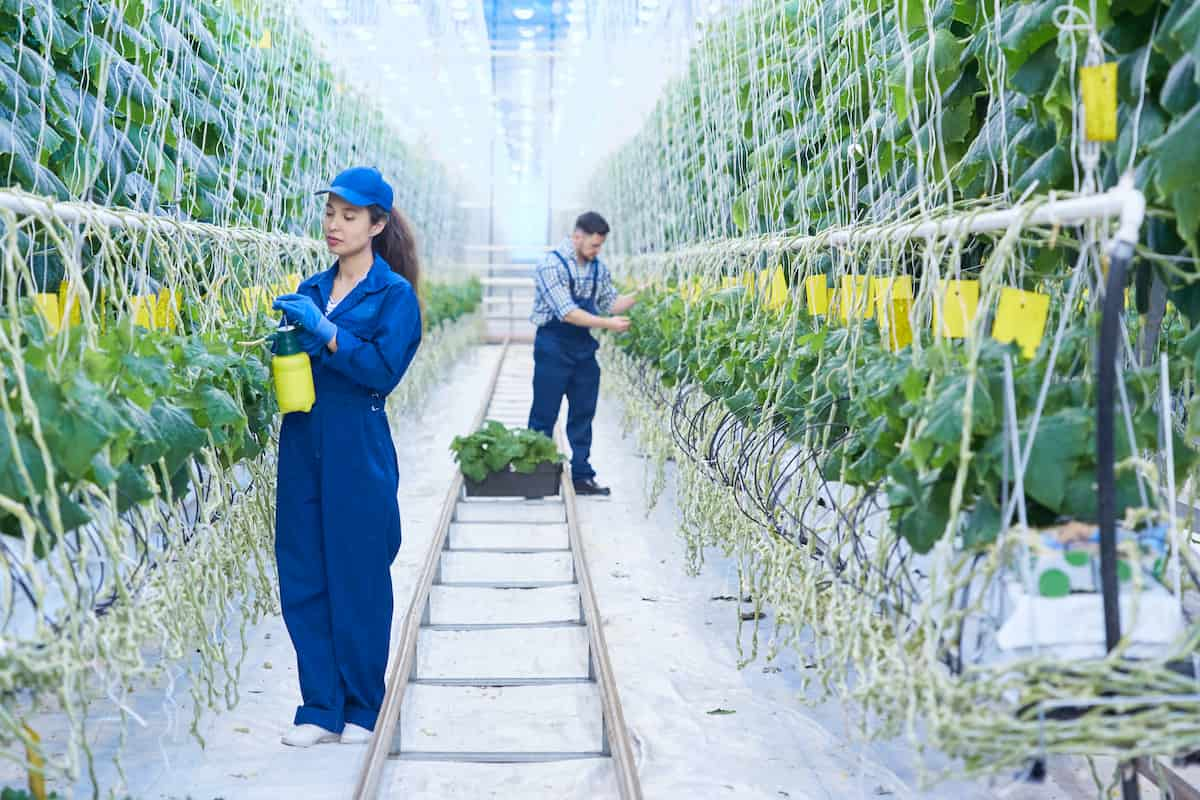Keeping your greenhouse plants healthy requires the management of pests. Due to food, warmth, and moisture availability in greenhouses, pest populations can develop rapidly. Early detection is critical if your brand is tarnished, recalls, liabilities, or even economic losses result. Otherwise, you may suffer from tarnished reputations, liabilities, or even economic loss.

An ant is one of the most common pests in greenhouses. When ants build nests above ground, they bury plants in soil; however, they disturb the soil around the plants when they form nests underground. Carpenter ants, for example, can cause structural damage.
How to Get Rid of Ants in Greenhouse
Common Ants Varieties in Greenhouses
There are over 10000 species of ants in the world at the moment. Many are extinct or do not attack plants. Here are some of the common ants you’ll see in your greenhouse.
- A common sight in greenhouses is the Lasius Niger (black garden ant), with an average population of 5000 ants per colony. The Lasius Niger anthill usually nests at the edge of patios and greenhouses. Their defense against predators is formic acid and their jaws.
- In addition to their Niger counterparts, Lasius Flavia (yellow meadow ant) is another common ant species found in gardens that are not so harmful. Seeing small mounds around your greenhouse is one of the most significant signs of Lasius Flavia in your greenhouse.
- Over 200 different species of fire ants can be found in your greenhouse. They are a common family of ants that you will most likely find in your greenhouse. Depending on your location, your greenhouse may contain the red imported fire ant (South America) or the European fire ant (Europe). Its reddish-brown color, and painful stings are characteristic of the fire ant.
- This is an aggressive greenhouse ant species with vibrant workers known as Crematogaster (acrobat ant). Known for attacking by raising their abdomens, they can be found nesting in moist wood in your greenhouse. Their color ranges from yellowish brown to reddish black.
How Ants are Harmful to Your Greenhouses
- Aphids, mealybugs, and scales produce honeydew, which ants use to feed on. You will see ant nests scattered on the stems and leaves of plants where honeydew-producing insects are gathered and guarded.
- As honeydew on plants creates mold, which produces dark spores, ants eat honeydew to protect plants. If ants farm aphids on plant roots, this can disrupt the roots and result in plant death.
- Ants bury plants in their nests when constructing nests. Furthermore, plants around nests are disturbed as nests are built beneath the earth.
- Several types of ants can be problematic. Fire ants are the most well-known ant species and can sting if provoked.
- When your plants are infested with fire ants, harvesting might become a nightmare. Their poison causes a painful welt that lasts for many days.
In case you missed it: How to Grow Geranium in a Greenhouse: A Step-by-Step Guide for Seed to Harvest

Controlling Ants in Greenhouse by Cultural Practises
- It is a good idea to dig in the autumn and spring and to loosen the soil frequently during the summer months. Ants do not like anxiety and will flee your greenhouse if you are anxious.
- Ensure the plant is free of sap-sucking pests like aphids so that ants will not hang around to collect honeydew.
- This technique works only if you know where the ants’ nest is. Also, note that ants build their homes to withstand rain and flooding, so it may take a few attempts to kill the queen.
- A bottle filled with nematodes can be filled with water and sprayed on the affected area to eliminate ant nests in a greenhouse. Nematodes are harmless to humans and plants.
Controlling Ants Organically in Greenhouse
As one of the safest treatments for insects, insecticidal soap leaves no residue on your plants or harvest if applied according to label instructions. The soap’s fatty acids will penetrate the pest’s outer covering, killing them. Don’t use soap in high temperatures since it can burn or stress plants.
Bacteria spray (BTI) registered for greenhouse use is host specific and won’t harm people or greenery. It is sprayed or sprinkled on the plants and eaten by pests, disrupting their digestive systems. As this spray can kill some beneficial insects within your greenhouse, use it only when necessary, closely following the label directions and with caution.
A neem tree’s fruit seeds can be used as a neem spray or oil spray. Spraying directly on plant leaves or insects disrupts development and feeding. When used as an oil spray, it blocks pests’ breathing pores. This product works best on immature insect pests.
Boric acid and Diatomaceous Earth: These are considered “Green” insecticides and can be used in dry areas of your greenhouse for ants and crawling insects, including cockroaches. If they are applied according to label instructions, they are safe. As the pest crawls, the treatment sticks to them, and the pest ingests it when it attempts to clean itself. The treatment disrupts digestion and the nervous system of the pest.
Controlling Ants Chemically in Greenhouse
- For some people, bait traps containing pesticides in enclosed forms may be preferred over sprays. They work by attracting ants to them, where they consume the bait and return some of it to their nests, killing off other ants. Bait traps can contain boric acid or borax, while others may contain hydramethylnon, a corrosive chemical compound harmful to children, pets, and plants that grow food.
- Fipronil affects the insect’s nervous system, is highly residual, and is not dangerous to humans or pets.
- A residual insecticide like deltamethrin, once dry, leaves an invisible film that repels ants and prevents them from entering your home. Ants cannot walk through the film and return it to their nest like they would with a non-repellent insecticide.
- Like bifenthrin and deltamethrin, permethrin is a contact insecticide with residual properties. It must come into direct contact with the ant to be effective.
- A contact insecticide with residual properties, imidacloprid was the widely used systemic insecticide for ants and termites for many years but is highly toxic to bees. Although it was systemic and absorbed by plants, imidacloprid did not leave much residue.
In case you missed it: How to Grow Avocado in a Greenhouse: A Step-by-Step Guide for Seed to Harvest

Conclusion
When seeking an effective way to get rid of ants from the greenhouse, the use of chemicals is rarely recommended. We have listed above a number of less toxic methods you can try in your greenhouse. These methods may require more than one treatment or a combination of methods to accomplish the task.
- Feed Your Flock for Less: Top 10 Tips to Save on Chicken Feed
- Ultimate Guide to Ossabaw Island Hog: Breeding, Raising, Diet, and Care
- Hatching Answers: The Top 10 Reasons Your Chickens Aren’t Laying Eggs
- Eggs and Economics: Breaking Down the Cost of Raising Backyard Chickens
- Defend Your Greens: Proven Methods to Keep Iguanas Out of Your Garden
- Ultimate Guide to Cinnamon Queen Chicken: A Comprehensive Guide for Beginners
- Ultimate Guide to California Tan Chicken: Breeding, Raising, Diet, Egg-Production and Care
- Ultimate Guide to Marsh Daisy Chicken: Breeding, Raising, Diet, and Care
- 10 Types of Chicken Farming Businesses You Can Start for Profits